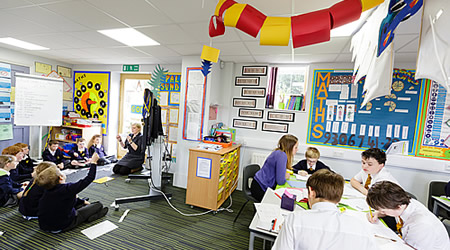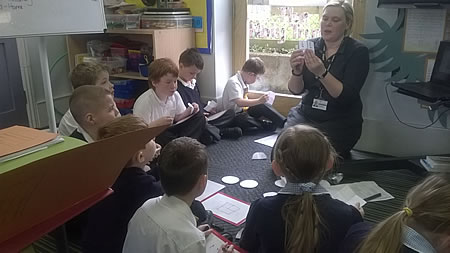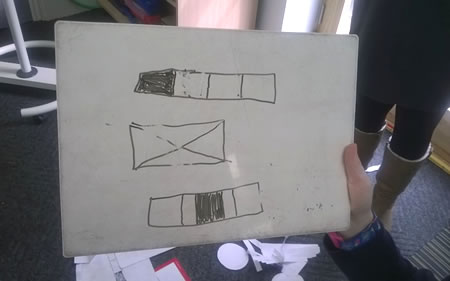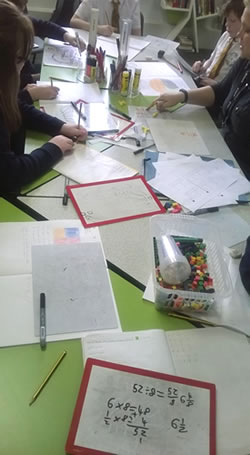How can teaching for mastery work in a mixed age class?
A group of schools in Northamptonshire have been addressing this issue, with encouraging results

One of the main tenets of a mastery curriculum is the principle of keeping the class together. All children study the same concept in the lesson, albeit at different depths. For many primary teachers, this raises the question: “How can this work for my mixed age class?” Although classes that span many year groups are largely the domain of small rural primary schools, many teachers in larger schools have classes that include children from two year groups. With a National Curriculum that ties learning explicitly to the age of the child, it is not always obvious how to adapt when a class spans more than one year group. A group of schools in Northamptonshire have been addressing this issue, with encouraging results.
Lucy Westley, maths lead for the Forest Federation of four tiny primary schools in Northamptonshire, is resoundingly positive about the impact of teaching for mastery in the mixed age classes she works with. A Mastery Specialist teacher participating in the Maths Hubs Programme through the Enigma Maths Hub, she teaches the older class at Tiffield CE Primary School which has only 42 on roll. Her pupils include children from Year 2 to Year 6.
Lucy teaching the Year 2/3s whilst the Year 4/5/6s work with the teaching assistant.
With such a wide spread of ages, Lucy first implemented some organisational changes in order to make a teaching for mastery approach feasible. To this end, she split her class in two – a higher age group and a lower age group – and, based on the individual pupils in those groups, chose to ‘aim’ the Year 5 maths curriculum at the older group, and the Year 2 curriculum at the younger group.
Lucy’s class
This year, this is the shape of most mornings in Lucy’s class:
| Time | Year 2/3 group | Year 4/5/6 group |
| 9:00-9:30 | Times Table Rock Stars | Times Table Rock Stars |
| 9:30 - 10:00 | Work on handwriting and grammar with TA | Maths teaching from Lucy - based on Year 5 curriculum objectives |
| 10:00-10:30 | Maths teaching from Lucy - based on Year 2 curriculum objectives | Work on handwriting and grammar with TA |
| BREAK | ||
| 11:00-11:30 | Individual maths practice on content taught | Lucy teaching literacy |
| 11:30-12:00 | Lucy teaching literacy | Individual maths practice on content taught |
| LUNCH | ||
| 1:15-1:45 | Pupils picked up for intervention by Lucy and/or TA as individuals or small groups; or silent reading | Pupils picked up for intervention by Lucy and/or TA as individuals or small groups; or silent reading |
At lunchtime, Lucy marks all the maths books and any children struggling are picked up for instant intervention after lunch. This time is also an opportunity to pick up any bits of the curriculum outside Years 2 and 5 that Lucy thinks necessary. Previously, the school used a four-part lesson structure (mental/oral starter, teacher-led time, group activities, plenary). Following a ‘pre-assessment’ at the beginning of each topic, pupils were grouped according to prior attainment, under an overarching objective. Each group then followed a specific ‘success criteria’ relating to the same mathematical strand, to climb a differentiated Learning Ladder. Lucy says that the focus on micro-progression with ‘Learning Ladders’ was similar to the mastery approach.
What is different is keeping the whole class together for the teaching episodes. Where previously she would ‘target teach’ small attainment-based groups, she is now target teaching across the attainment spread, more focused on year groups. The aim of the current approach is to create fluidity – children not bound by specific expectations of achievement, and able to move at their own pace with each new concept. The focus is on children achieving deep conceptual understanding and fluency with every topic. No child is accelerated beyond the primary curriculum. Pupils are seated in small groups of varied confidence and attainment during the taught sessions – Lucy thinks about who will work supportively together, and other social considerations. For the individual practice, pupils are grouped with the few others from their year group. Lucy has clear expectations that pupils will help teach one another both on their tables and in explaining things to the whole class. She recognises that this forms an important part of learning for all pupils.
Lucy made the decision to split the class as she did, and follow the Year 2 and Year 5 objectives respectively, based on the individuals in the class this year, and their specific needs. She recognises that this will be different every year and for each school, depending on pupils’ needs, but feels that small schools have the flexibility to be responsive to individual needs of their pupils. She encourages the schools she works with to look at their own situations and pupils, and structure their timetables accordingly.
With the new structure in place, Lucy has also changed the way that she teaches, using techniques generic to any class following a mastery curriculum, most notably: a steady pace, plenty of pupil talk, plenty of variation, and broad use of the CPA (concrete/pictorial/abstract) approach.
First of all, she has slowed the pace down enormously, breaking all the learning into small manageable chunks.
“You could see all these lightbulbs going on in the kids’ eyes because you took these small manageable steps,” she says of their first attempts with teaching a fractions module.
Both Lucy and her headteacher, Eliza Hollis, feel strongly that the previous curriculum did not adequately prepare children for secondary education because of its emphasis on accelerated progression through the levels rather than deep fundamental understanding of the mechanics of arithmetic.
"We just kept going up and up,” she says, “so they’d get that bit, tick, done it. Long division with big remainders, tick, got that, let’s move on. And you knew, hand on heart, that they hadn’t got it – because you hadn’t presented it in different ways, you hadn’t got that variation there, and you’d see differentiation as ‘we’re doing bigger numbers’ or ‘we’re doing smaller numbers’".
Variation theory
Lucy is a firm believer in the use of variation theory, something we saw on the day of our visit when she was teaching younger children about fractions and, in particular, quarters. With paper cut into various shapes, Lucy asked them to fold the paper into quarters.
All children managed the paper circle easily, and the square caused no problems either, with some discussion about different ways of doing this. Then Lucy gave the children rectangular strips of paper and again asked them to fold into quarters. This exposed that some did not have any real depth of understanding. Some children put in too many folds, possibly because they had folded it four times rather than halving and halving again. The variation in representation had caused all the children to challenge and deepen their understanding of what it meant to divide a shape into quarters. Lucy then asked them to draw their own shapes split into three quarters and one quarter. Despite all children working on the same task, Lucy’s open question allowed them to show different levels of understanding and for them to challenge themselves at their own level. One girl drew this:
This girl shows great depth of understanding in her third diagram – that the four equal parts of the whole do not need to be in four pieces to achieve quarters. She came up with this idea independently, demonstrating the depth that can be achieved by focusing in on a small chunk of learning
The CPA approach
Lucy is a big advocate of the CPA approach to learning and has begun illustrating her teaching with physical objects wherever she can. For example, in teaching the older half of her class to divide numbers to give fractional answers, she began by putting six apples on each table and asking if they could be divided equally between the varying number of children sitting at the tables. During the intervention session later on, with Year 5/6 children, Lucy used small cubes to demonstrate for questions such as 2 ÷ 5 dividing each unit into fifths. When tackling the questions, some children used the cubes, others drew pictorial representations on their mini whiteboards, and others were confident to go straight to using an abstract method. Each child seemed confident in using whichever method felt best for them, and in moving between methods.
A discussion ensued between a boy who had solved 52 ÷ 8 using an abstract method, and was then trying to explain it to the boy next to him using a picture. He started drawing 52 dots on his whiteboard then, realising the inefficiency of this, started counting out cubes, using five ‘tens’ sticks and two 'units' cubes. As he was doing this, another boy on the table was getting very excited because he had already anticipated the need to ‘break up’ the tens to do the division. The depth of understanding demonstrated and engendered by this sort of discussion between pupils shows mastery at its most powerful. The boy who had ‘got it’, was being helped in his understanding by the other two boys, as much as he was helping in theirs.
Concrete/pictorial/abstract: the boy working on the board in the foreground was calculating entirely in the abstract (and able to check his work using reverse operations). The teacher is demonstrating the calculation using the cubes. The girl on the left at the top of the table is drawing a picture to illustrate the division
In order to collect feedback on the new approach to teaching and learning maths, pupils at Lucy’s school have filled in questionnaires. “Without doubt, I would say, all the children say it’s their favourite subject at the moment – they all seem to be really inspired with it. I think it’s because the steps are so small that they feel like they are achieving in every single lesson. They enjoy that feeling of ‘it’s little tiny steps that I’m taking but I know where it’s leading in the end’. In our school it’s been absolutely brilliant.”
Lucy’s wider role across the federation
To begin with, despite her own willingness to give mastery a go, Lucy found some colleagues in the Forest Federation more sceptical. Following mastery training, assistant heads in three schools together identified fractions as an area that their children always found difficult, so planned and trialled a Year 3 unit.
“It was amazing because every time we met, we were all going ‘These kids are getting it! These kids are really understanding it!’ They could see it, feel it, they knew it! And it went very quickly to the abstract and that’s when we were all convinced – that was the lightbulb for us.”
Following the trial, the assistant heads were able to support the other teachers in their school to give it a go.
“We did lots of training, showing ‘these are the sort of things the children are coming out with’. We trialled maths journals* so that other teachers could see just how important it was for the children to put down their own thoughts about the maths. Teachers could see the children’s thinking so clearly, they could see the progress that they were making. And then everybody has trialled it, and the messages have all been the same – that this approach is really working for our children”
Going forward into the next academic year, Lucy acknowledges that she will have a very different profile to her class, losing a particularly high-attaining Year 6 cohort and gaining the other half of Year 2. She is already looking ahead to this challenge and drawing up a 'long-term map' that will not involve her pupils in repeating the curriculum she has taught them this year.
Other schools in the federation will be tailoring their curricula to the needs of their own situations. This year, one school, with a mixed Year 4/5/6 class, is target teaching in year groups using mastery methods with each. Another school, with a mixed Year 5/6 class, mostly teaches the class together, splitting sometimes when necessary. “It’s the principles of mastery that we think are important for our children.”
Lucy’s advice for others with reservations about the application of the mastery curriculum for mixed age classes is:
“I think you do have to jump on board and try it and see the difference, really see it pay off, and then make your mind up. I think people have to give it a go."
* A maths journal is a pupil's own notebook, where they might try out their own ideas, reflect on what they have learnt, or make a note of important points or key ideas.
The issue of a teaching for mastery approach in a mixed-age class was at the centre of a project run jointly by Jurassic Maths Hub, Cornwall and West Devon Maths Hub and Babcock LDP, who run education in Devon. This was described in an article in the NCETM’s Primary Magazine in spring 2015, and there are also several video clips of the teachers involved in the project on on the Babcock website.
This case study was first published in 2016.



